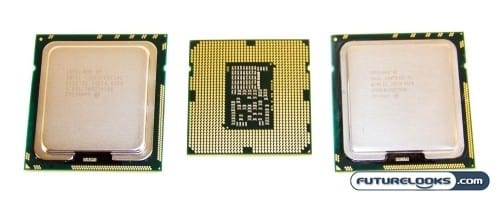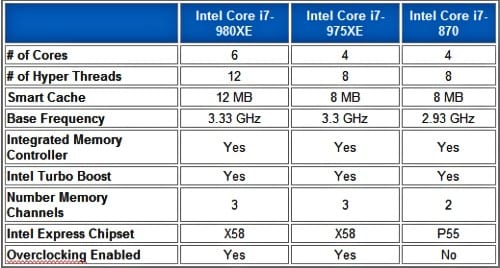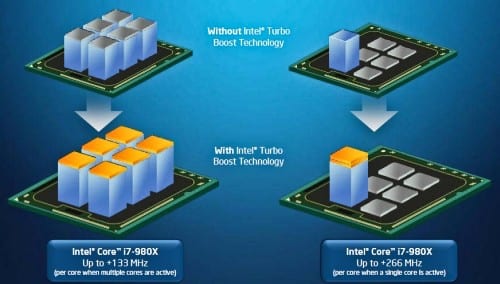
It almost seems like yesterday that I started down the yellow brick road to technology with my first real office computer which had an Intel 80486DX2 Processor. A couple years later, the local PC store built me an “adequate” gaming computer using a Pentium III 750MHz Slot 1 processor while socket 1 processors were still in the day dreaming phase.
Today’s processor technology is the result of years of innovative thinking put to action. For instance, Intel’s microprocessor architecture has proven that we’ve taken the first steps into an era where computers are capable of doing far more than just calculating a few spread sheets or playing video games.
There is a lot more unlocked potential from Intel and if you love your Quad-Core i7, then you’re going to love this! How about a 6-core Intel Core i7-980XE Gulftown 32nm Processor? That’s right! We’ve got Hexa-Core!
Features and Specifications
Where to begin.Well, let’s start with the obvious differences between all the Core i7 processors in Intel’s arsenal. This helpful little graph is far easier to read than endless text.
One feature design that makes the 6-Core Gulftown an impressive revoluationary processor is power consumption. To put it into perspective, AMD’s first revision Phenom II X4 965 processor consumes 140 Watts TDP (125 Watts in recent revisions). The Core i7 920 to 975XE processors carry a max 130 Watts TDP and that includes the new 6-Core Gulftown. That’s extremely impressive given that it powers 2 extra cores flexing 4 HyperThreads.
The 6-Core Gulftown is a 32nm processor that shares a couple important features with the 45nm Core i5/i7 Lynnfield and 32nm Core i3/i5 Clarkdale; a 2-core processor with hyper-threading that makes it perform like a quad core.
Other similarities include Intel Turbo Boost Tech which dynamically overclocks the processor frequency when needed, Overclocking Enabling, and Integrated Memory Controllers. But again, it’ll be a lot easier if we just show you.

Power users say that you can never have too much L3 Cache, or in this case, Smart Cache. This next generation Xtreme Edition processor carries a whopping 12 MB Smart Cache. That’s 10 MB more cache than a couple generations ago when we thought 2MBs was enough.
Intel Turbo Boost and SpeedStep
Now, a lot of folks have still been getting the features Intel Turbo Boost and Intel SpeedStep confused. The two are not the same thing and have completely different purposes. Intel Turbo Boost is a feature built in to Core i3, i5, and i7 processors that automatically overclocks the CPU frequency when you’re using an application that requires all or just one of the cores.

For instance, many games are still single threaded and will utilize only one CPU core even if your proessor has four. Turbo Boost will overclock just one core by a few hundred MHz to aid the application when needed. That’s why the Core i5 661 Clarkdale does so well in many game titles like Crysis, because the game only uses only one core.
Gulftown Design
Like the Bloomfield processor, Gulftown’s memory controller accesses three DDR3 memory sticks at once, called Triple Channel. The memory controller makes sure there is ample memory bandwidth readily available for each core when it requires it. The average memory bandwidth is somewhere in the neighborhood of 25 GB/s using Triple Channel 1066MHz DDR3 memory. That’s a lot more than the Penryn generation’s 6.5 GB/s with the memory controller that was integrated within the chipset. One can easily imagine what 1800MHz DDR3 memory would offer Gulftown platform. That’s a lot of “Farmville”.
The Core Family
Here you can see the Core i7-980XE (left), Core i5-661 Clarkdale (middle), and Core i7-975XE (right). It’s all pretty uneventful looking except to say there’s no way engineers would’ve been able to pack 6 of the Nehalems 45nm cores on the same sized PCB.
Being an LGA1366 socket processor, the Gulftown is only going to fit on motherboards powered by the Intel X58 Chipset. Many of the X58 that are shipping today will probably already support Gulftown, but you should still check the retailer’s production page to double check. Otherwise, be prepared to flash the BIOS with a newer version if you have an earlier shipped board.
The main reasons why the 6-Core Gulftown is only supported by the X58 Chipset is the platform’s design. In a nut shell, it’s because X58 is a true power user chipset. It offers all the maximum resources available for professional users to accomplish their objectives in an expeditious manner. That includes full speed PCI Express lanes that share nothing with other components.
Test System Configuration
GIGABYTE sent us their GA-X58A-UD5 Motherboard flashed to the Gulftown ready F4 BIOS. The new retail XE CPU cooler was installed and given some bench time to make sure it works. More on that later.
Here is the break down of the test system:
- Processor 1: Intel Core i7-870 Lynnfield
- Processor 2: Intel Core i7-975EE Bloomfield
- Processor 3: Intel Core i7-980X EE Gulftown
- GIGABYTE GA-X58A-UD5 Motherboard
- Patriot Memory ViperII 6GB 2000MHz DDR3 @ 1600MHz CAS7
- Zotac Geforce GTX295 Graphics Card
- Kingston SSDNow V+ 128GB (Rev 2)
- Antec 1000 Watt Quattro
- Windows 7 64-bit Operating System
- Benchmarks: SANDRA CPU, SANDRA Memory Bandwidth, SANDRA Multi-Core, Cinebench R11.5, Unigine Heaven Demo, 3DMark Vantage, Crysis, HandBrake, and DIVX 1080P Encoding
Just a reminder or two here. Don’t forget to make sure the motherboard you’re ordering for your 980XE already has the BIOS needed to support the hexa-core processor. Otherwise, you’ll be sitting there with a system that boot up. Without another Core i7 to make that happen, you’ll be in a pickle.
The NEW Intel Retail XE CPU Cooler Tested
The new tower cooler, a departure from the little round hunk of aluminum, sports a polished copper base, copper heat pipes, and about five inches of stacked fins to help dissipate heat. As you may already know, copper heat pipes are excellent for efficiently carrying heat away from the processor. It’s up to the two speed (Q-quiet and P-performance) 92mm fan to keep all that cool. While we aren’t sure of the 92mm fan’s specs, these fans usually require some higher RPMs to do so.
We’d like to point out that the new Intel XE CPU Cooler did a much better job of cooling the 980XE than the old school cooler by far. With the fan speed on low, it idled at 26C and load was 68C. On high, it idled at 25C and hit a loaded high of 64C.
How was the noise? On the Q setting, the fan is roughly 31dB when measured two feet away. Using the P setting, noise levels hummed to a whopping 50dB! I started to wonder if the XE cooler was going to carry the motherboard off. It’s clear that the 92mm fan may not be the right choice and going with a much more efficient and quieter 120mm fan may be a better choice. There is still room for improvement as Intel may still consider that option.
This also tells us is that the old school retail cooler could not have handled the job of cooling the 6-Core Gulftown. The XE’s can do the job, but the design wastes a lot of air in different directions. A fan shroud would channel the air through cooling more efficiently, requiring less RPMs, and thus, hopefully drop some noise. The 130W TDP just doesn’t warrant the air plane propeller action.
We didn’t want the new processor to suffer a heat stroke during some BIOS experimentation, sometimes called overclocking. The 6-cores can get quite hot once the voltages are applied. Thus, it was very necessary to use a Thermalright Venomous X CPU Cooler since we know these kinds of tower coolers do very well.
For example, the Thermalright Venomous X started off at 22C and topped out at 57C using a SilenX 120mm low RPM quiet fan, compared to the 64C of the new stock Intel cooler. Thanks to AcousticPC who carries the best quality made computer hardware to quiet your PC for providing this cooler.
Overclocking 6-Cores!
The first thing we did was try pushing the CPU Bus to a max of 180MHz before some more serious voltage had to be applied. But, that meant dropping the multiplier as well. Next, we left the multiplier at default and reached a maximum of 172MHz Bus Speed. That gave us a core frequency of 4.472GHz!
The motherboard you use is the most important component to ensure stability. The platform’s voltage characteristics will effect the overall results. With some more experimentation, the platform would probably hit 4.6GHz. But, you should really use some more extreme cooling for those efforts.
Now, some perspective. The bulk of the owners won’t even consider overclocking. Other than a few of us benchmark crazies around the world who shoot for setting world records, or just show off, there is really no good reason you would need to overclock a CPU like the Core i7 980X. But, at least you get an idea how well the CPU does on GIGABYTE’s GA-X58A-UD5 motherboard.
SANDRA CPU Scores
No, you’re not hallucinating. While I’m still quite happy with my 975’s scores, the 980 left me shocked as well. Just to make sure, the benchmark was run several times. SANDRA’s Mathematical and Multimedia benchmarks always seem to put it in persepctive.
SANDRA Multi-Core Efficiency
We threw this benchmark in this round to show you some tangible benefits built in to the processor. With more frequency, memory controllers, and improved execution instructions, the 980 is capable of working with about 51 GB/s if not more. Let’s look at the memory controller’s update.
SANDRA Memory Bandwidth
Thanks to the integrated memory controller, the entire Core i7 series readily has 26GB/s, and more, memory bandwidth to work with. The extra cores and Hyper-Threads see an increase even without overclocking the CPU frequency. That will come in handy with multi-threaded programs like Adobe CS.
Cinebench R11.5
Cinebench R11.5 is brand new this review. We had to retire R10 after encountering some odd Hyper-Thread issues during testing. We’ve left the large benchmark scores behind and moved to CPU Points. It’ll take some getting use to for us, but the 980 has no problem kicking some benchmark a$$.
3DMark Vantage
We knew the 980 would have a faster CPU Score. But, we’re talking about 8 thousand points difference. Since the same GTX295 was used on each system, it makes sense that there’s little GPU Score difference.
Unigine Heaven Demo
The Heaven Demo is one of my new favorite 3D benchmarks because it tests DX9, DX10, and DX11 as well as the point something or others in between. There’s a noticeable average frame rate difference. But, it’s the Score that changes the most leaving my Core i7 870 gaming machine spinning.
Crysis
Yes, sure, we know the 980 is complete overkill and a waste for just gaming, but we’re adding this just for those few extreme fanatics (like myself) who have been known to sport the craziest hardware at big LAN parties. Turbo was enabled on all three platforms since it’s a feature worth having on while gaming.
Graysky x264 HD Benchmark 3.0
This handy benchmark tool can be downloaded at many locations. It dual pass encodes a small 720p video and presents you with frame rate averages. Not surprisingly, the 980X is a media beast besting my precious Core i7 975.
Windows Media Encoder 9
Being that Media Encoder 9 is readily down loadable from MS, using the same similar sized file like Graysky’s HD test, we get a quick peak at the multimedia potential. It was in fact, almost 20 seconds, but we rounded it up. That’s right, media-philes start your drooling!
Final Thoughts on the Gulftown
Yep! It’s fast. This thing is a content creator’s new dream machine. With its new innovative 32nm micro architecture, surprisingly low 130W power consumption, two extra cores with dual Hyper-Threads, 7 new processor instructions, improved memory controller, Turbo Boost, and new racing exhaust straight off the block of GT-R, the Intel Core i7-980X left “fast” standing at the starting line.
In the coming weeks, you’ll be able to upgrade your 300hp processor for a 485hp processor requiring the usual premium: arm and leg. And, like any top of the line processors, the money in your sofa won’t be enough. Keep in mind, you’re not paying much more if any than you did when you bought your prized Core i7 975 Nehalem the first time.
After a few rounds with the Mohammad Ali of processors, we’re really anxious to see what AMD sends our way. What a heavy weight fight that’s going to be!
Pros
- The fastest processor on the market
- 6-Cores powering 12 Hyper-Threads
- 32nm design requiring only 130W TDP
- Unrivaled desktop and content creation performance
- Innovative as always
- No LGA1366 motherboard upgrade needed
Cons
- Requires the standard premium
- No lower 6-Core models at this time?
Overall Rating: 9.5/10.0
Love This Review? Hate This Review? You Gotta Tell Us!
Intel Core i7-980XE Gulftown 6-Core 32nm Processor Photo Gallery

